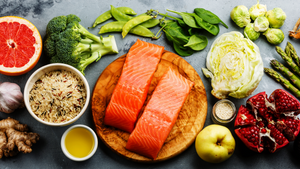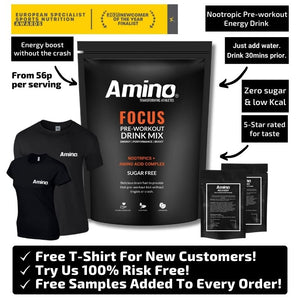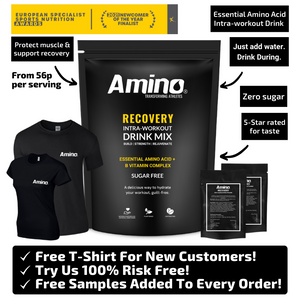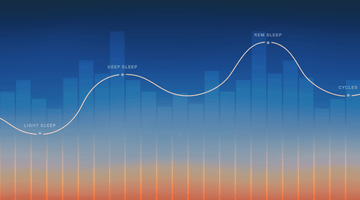‘Clean eating’ is no longer just a buzzword touted around by influencers and journalists. Many of us want to know that the foods and supplements we eat not only fuel our performance but that they come from clean, sustainable sources.
Consequently, ‘clean eating’ refers to a diet free from processed foods and those that contain added fats, sugars and chemicals – all with a view to maintaining optimal health.
But, while reading food and supplement labels sounds easy enough, deciphering them isn’t always easy. Nutrition labels and ingredients lists can be confusing, filled with numbers, symbols and unrecognisable terms.
In this article, we’ll guide you through the key points to look out for, so you can maintain a clean diet.
AMINO’S GUIDE TO THE (UK) NUTRITION PANEL
Energy: Carbohydrates
Sugars
Sugars come in many guises, but there are two main types to look out for:
- Natural Sugars: These are found in most fruits and vegetables. Natural sugars are typically harmless if consumed as part of the whole fruit, because the natural fibre counteracts the effects. But beware of juice: the sugars are not counteracted by fibre so should be consumed in moderation.
- Added Sugars: These are added to products by manufacturers to make them taste better – but it also makes them more calorific. If you’re unsure whether there are added sugars present, look for words ending in ‘-ose’ in the ingredients list. Remember: while products such as agave and stevia are natural, they still add to the calorie count.
Fats
- Saturated Fat: This can contribute to high cholesterol, leading to heart disease and other ailments. Typically animal fats are saturated, although coconut oil also falls into this category. If you’re unsure, remember that saturated fat tends to be solid at room temperature. Consume in moderation.
- Trans Fat: You should avoid these wherever possible. While some are natural and come from animal products, others have been combined with hydrogen (hydrogenated) to encourage them to solidify. They tend to increase levels of bad cholesterol, resulting in heart disease.
- Unsaturated Fat: Often known as ‘good fats’, these are less likely to raise your cholesterol levels than other types, so can be enjoyed more freely. Look out for oils derived from plants or fish.
Other nutrients
Sodium
Sodium refers to salt (the molecule is made up of sodium chloride) and should be consumed in moderation.
While sodium is vital to the normal functioning of most cells, too much can have an adverse effect on your blood pressure and hydration levels. The British Food Standards Agency recommends consuming no more than 6mg per day.
Again, it’s often added to processed and convenience food to make it taste better and flavoursome. If you’re committed to clean eating, it’s a good idea to avoid processed food and ready meals.
Fibre
Fibre is a wonder nutrient.
It sounds like an exaggeration, but it’s believed that fibre can reduce the likelihood of heart disease, type 2 diabetes and bowel cancer. It may even help you lose weight because it helps you to feel fuller for longer.
The British Nutrition Foundation recommends that adults eat at least 30g of fibre per day to feel the benefit. Grains, vegetables, fruits and nuts are all good sources of fibre and can easily be added to a healthy diet.
Protein
As you’ll know from reading other articles on this site, protein is essential for building strong bones and muscles.
During digestion, dietary protein is broken down into its component parts (amino acids) and then rebuilt into muscle and other tissues. There are 20 amino acids in total and while our bodies can make 11 of them, the other 9 (known as EAAs) must come from our diets.
The amount of protein you need varies according to a wide range of factors, including age, activity levels and general health, but if you’re eating clean, opt for lean sources of protein wherever possible, including beans and pulses.
Tackling the Ingredients List
It’s not just the nutrition panel that’s complicated. The ingredients list can also include confusing words and terms. This section separates the good from the bad – and the downright ugly!
Green lights: The good:
- Folic acid: It’s not just for pregnant women. It actually helps with a process called methylation, which is believed to play a role in detoxification and more. Sources include green leafy veg, such as spinach, broccoli and kale.
- Chelated compounds: These make minerals easier to absorb, so your body can use them. Look out for minerals with ‘di-’ added to the beginning (for instance, dimagnesium) on the ingredients label.
Red flags: The bad:
While the jury is still out on the health impact of these chemicals, you may choose to avoid them if you want to keep your diet clean.
- Artificial flavours: These chemicals are often made from ingredients such as paper pulp or petroleum. They mimic the taste and smell of natural ingredients to make products more appealing. While they’re not typically harmful, it is a sign that the food may be low quality.
- Artificial preservatives: These are added to foods to make them last longer. There are several to look out for but research shows that butylated hydroxyanisole (BHA) and butylated hydroxytoluene (BHT) may be carcinogenic.
- Artificial food colourings: Usually, these are listed as red, blue, or yellow, followed by a number. Research into their impact is ongoing, but some compounds are linked to cancer.
- Artificial sweeteners: Sucralose, aspartame, acesulfame potassium and saccharin have all been linked to cancer in animal studies. They are also thought to have a negative impact on your gut bacteria, while some studies show that saccharine can make you crave more sweet stuff.
Toxic ingredients
- Titanium dioxide: Commonly used in paint, cosmetics, paper and sunscreen, titanium dioxide has no nutrient value and serves only as a filler to whiten products. Also known as E171, it is allowed in very limited amounts, but has been linked to allergies, stomach cancer, autoimmune disorders and organ toxicity. In 2020, the EU ruled that it isn’t safe to use as an additive.
- Magnesium silicate: Also known as talc, this compound is often found in deodorant and cosmetics. However, it is also commonly found in the coating of supplements and vitamins in pill form. It has been linked to the high rate of stomach cancer in Japan, where it is used to whiten rice – although studies into this are ongoing.
Supplement fillers
The following compounds are often used to bulk out supplements and save manufacturers money. If you’re looking for clean supplements, avoid these compounds:
- Magnesium stearate
- Silicon dioxide
- Titanium dioxide
- Starch
- Microcrystalline cellulose
- Stearic acid
- Simethicone
- Vegetable gum
- Propylene glycol
Be sure to buy high-quality supplements. While they may cost you a little more, they’re less likely to contain filler chemicals.
Remember: If you’re vegan, vegetarian, or just prefer a plant-based diet, make sure your supplements are certified vegan. Many amino acid and vitamin D supplements are derived from waste products such as animal hair, sheep wool, nails and bird feathers. Plus, most omega 3 comes from processed fish oil or fish livers.
Want to know more?
Drop us a line via live chat if you have questions around supplementation and nutrition.






